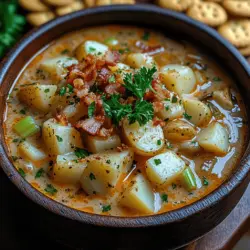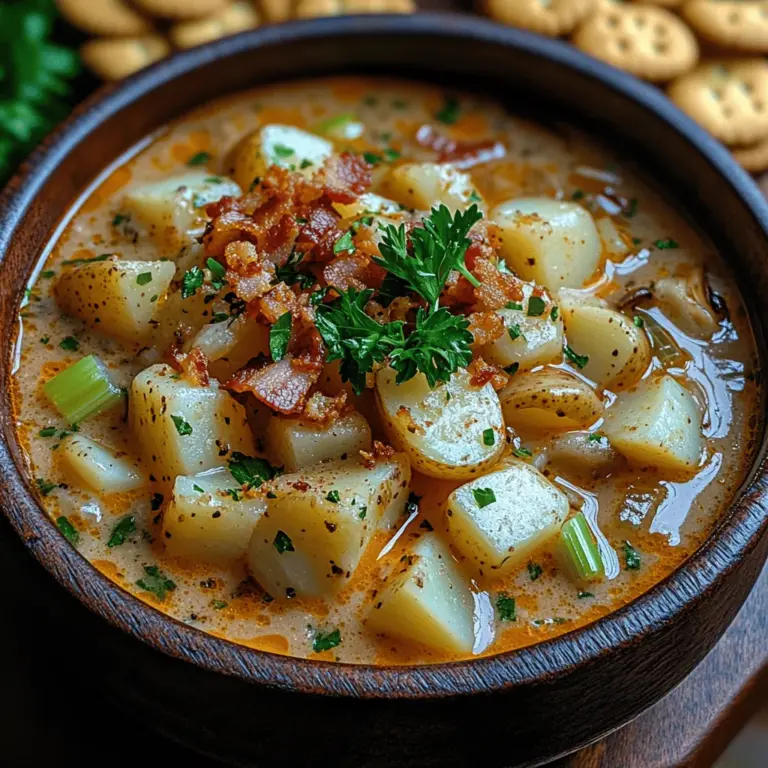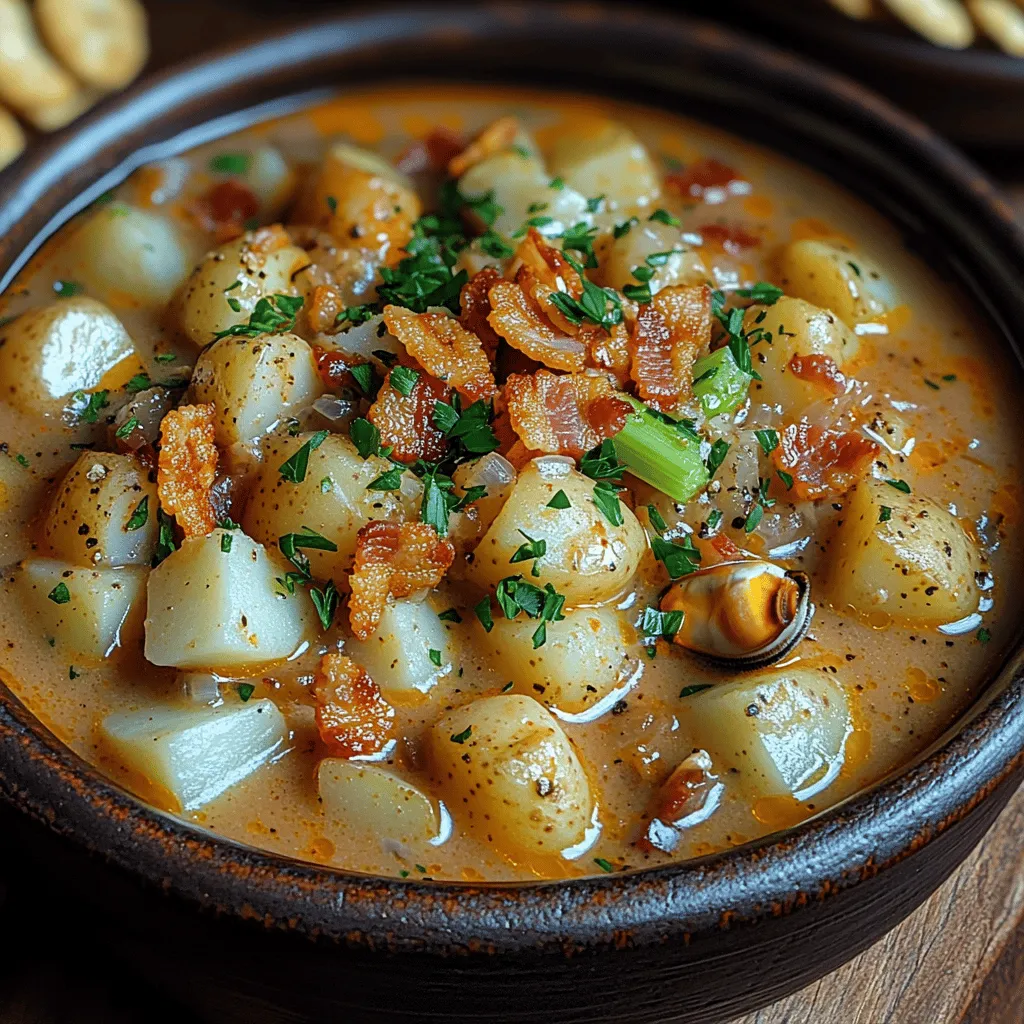Welcome to the world of Classic New England Clam Chowder, a dish that captures the essence of coastal New England cuisine with each creamy, rich spoonful. This beloved soup is not just a meal; it’s a comforting experience that evokes memories of salty sea breezes, quaint seaside shacks, and family gatherings. Bursting with tender clams, smoky bacon, and fresh vegetables, this chowder is much more than a recipe—it’s a tradition steeped in history and culture.
In this article, we will explore the origins of clam chowder, discuss its significance in American culinary history, and provide you with a detailed recipe to guide you in crafting your own delicious bowl of this iconic dish.
Understanding Clam Chowder: A Culinary Tradition
The History of Clam Chowder
The roots of clam chowder run deep into the history of New England, dating back to the 18th century. Originally, chowder was a term used for any kind of soup or stew, but it quickly became synonymous with the creamy concoctions that showcased the coastal bounties of the region. The first known recipe for clam chowder appeared in a Boston newspaper in 1836, and from there, its popularity soared.
Traditionally, New England chowder was made with local ingredients, including clams harvested from the Atlantic Ocean, fresh vegetables, and milk or cream. The combination of these simple, hearty ingredients created a dish that was both nutritious and satisfying, making it a staple for fishermen and families alike.
As the recipe spread beyond New England, it encountered variations that reflected local tastes and available ingredients. One of the most notable alternatives is Manhattan clam chowder, which utilizes a tomato-based broth instead of cream. However, it is the creamy, rich flavor of New England clam chowder that continues to captivate palates, earning it a special place in the hearts of many.
Key Ingredients that Shine
At the heart of Classic New England Clam Chowder lies a selection of ingredients that elevate the dish from ordinary to extraordinary. Each component plays a crucial role in building the chowder’s signature flavor and texture.
1. Clams: The main star of the dish, clams provide a briny essence that is unmistakably tied to the ocean. Fresh, tender clams are ideal, but canned clams can also be used for convenience. The clams not only contribute to the flavor but also lend a delightful chewy texture.
2. Bacon: This smoky ingredient adds depth and richness to the chowder. The rendered fat from the bacon is vital for sautéing the vegetables, infusing them with flavor. Plus, the crispy bits of bacon add a wonderful contrast to the creamy soup.
3. Potatoes: Typically, Yukon Gold potatoes are the preferred choice due to their creamy texture and ability to hold their shape. They absorb the flavors of the broth while providing the necessary heartiness to the chowder.
4. Onions and Celery: These aromatics form the flavor base of the chowder. Sautéing them releases their natural sweetness and enhances the overall taste.
5. Milk and Cream: A combination of these two ingredients creates the chowder’s signature creaminess. The balance of milk and cream allows for a rich texture without overwhelming the dish.
6. Clam Juice: This flavorful liquid, derived from cooking the clams, is essential for enhancing the chowder’s briny flavor. It serves as the backbone of the broth and ties all the ingredients together.
Understanding the significance of these ingredients will not only help you appreciate the dish more deeply but will also guide you in selecting the best components for your chowder.
The Recipe: Classic New England Clam Chowder
Gathering Your Ingredients
Before you embark on your chowder-making journey, it’s essential to gather all the necessary ingredients. Here’s what you’ll need:
– Fresh clams (or canned clams for convenience)
– Bacon (about 4-6 slices)
– Yukon Gold potatoes (2-3 medium-sized, diced)
– Onion (1 medium, finely chopped)
– Celery (1-2 stalks, finely chopped)
– Garlic (2-3 cloves, minced)
– Milk (2 cups)
– Heavy cream (1 cup)
– Clam juice (2 cups)
– Thyme (fresh or dried)
– Bay leaves (1-2)
– Salt and pepper (to taste)
– Butter (optional, for added richness)
Step-by-Step Instructions
1. Cooking the Bacon
To begin crafting your Classic New England Clam Chowder, you’ll want to start by cooking the bacon. This step is crucial, as it not only adds flavor but also provides the fat needed for sautéing your vegetables.
– Cook the bacon: In a large pot or Dutch oven, place the bacon strips over medium heat. Cook until the bacon is crispy and golden brown, about 5-7 minutes. Be sure to turn the strips occasionally to ensure even cooking.
– Render the fat: Once the bacon is cooked, remove it from the pot and place it on a paper towel-lined plate to drain excess grease. Leave the rendered fat in the pot, as this will serve as the flavorful base for your chowder.
2. Sautéing the Aromatics
With the bacon cooked, it’s time to layer in the flavors by sautéing the aromatics—onions, celery, and garlic.
– Add the onions and celery: In the same pot with the bacon fat, add the chopped onions and celery. Sauté for about 5 minutes, or until the vegetables are softened and the onions become translucent. This step is key to building the flavor profile of your chowder.
– Incorporate the garlic: Once the onions and celery are tender, add the minced garlic and sauté for an additional 1-2 minutes. Be careful not to burn the garlic, as it can turn bitter.
3. Adding Potatoes and Liquids
Now that your aromatics are fragrant and flavorful, it’s time to add the potatoes and the liquids that will form the chowder’s base.
– Add the diced potatoes: Stir in the cubed Yukon Gold potatoes, ensuring they are well-coated in the aromatic mixture. The potatoes will absorb the flavorful broth as they cook.
– Pour in the clam juice: Next, add the clam juice and give it a good stir. This will start to create the chowder’s broth, and the clam juice will enhance the overall flavor.
– Add water if necessary: If you find that the clam juice isn’t enough to cover the potatoes, feel free to add a little water to ensure they are immersed.
– Season: Toss in the bay leaves and thyme, and season with salt and pepper to taste. Bring the mixture to a gentle boil, then reduce the heat and let it simmer until the potatoes are tender, about 10-15 minutes.
4. Incorporating Cream and Clams
Once the potatoes are cooked through, it’s time to finish off your chowder with the creamy elements and the clams.
– Add the cream and milk: Gradually stir in the heavy cream and milk, ensuring the heat is low enough to prevent curdling. This will create the creamy texture that is characteristic of New England clam chowder.
– Incorporate the clams: Finally, add the clams to the pot, either drained from a can or freshly steamed. Stir gently to combine, allowing the clams to heat through without overcooking them.
– Adjust seasoning: Taste your chowder and adjust the seasoning as necessary, adding more salt, pepper, or herbs according to your preference.
This step concludes the cooking process, leaving you with a beautifully rich and creamy chowder that embodies the essence of New England.
As we continue with the next part of the article, we’ll explore additional tips for achieving the perfect clam chowder and address some common questions that arise when making this classic dish. Stay tuned for more insights on creating a bowl of chowder that warms the heart and delights the palate.
Highlighting the Role of Clams in Classic New England Clam Chowder
The clams are the star of the show in a Classic New England Clam Chowder, providing not only a distinct flavor but also a rich source of nutrients. When using fresh clams, it’s essential to ensure they are properly cleaned before adding them to the chowder. This process typically involves soaking them in cold water for about 30 minutes, allowing any sand to be expelled. Rinse them thoroughly under cold water, scrubbing the shells to remove any debris.
Once your clams are prepped, it’s time to incorporate them into the chowder. After simmering the base of your chowder with potatoes, onions, and celery, add the clams at the right moment to ensure they cook perfectly without becoming tough. Typically, you’ll want to add the clams during the last 10 minutes of cooking. This allows them to steam open and release their briny essence into the chowder, enriching the entire dish.
Finishing Touches
As you approach the final stages of your chowder preparation, it’s important to season thoughtfully. After adding the clams, taste the chowder and season it with salt and freshly ground black pepper to enhance the flavors. Remember, the clams and broth will contribute some saltiness, so adjust according to your preference.
Before serving, don’t forget to remove the bay leaf. This aromatic leaf has imparted its flavor during cooking but should not be consumed. Once the bay leaf is discarded, it’s time to add a flourish to your chowder. Garnish with freshly chopped parsley for a pop of color and a hint of freshness. If you wish to add a traditional touch, consider offering oyster crackers alongside the chowder, which provide a delightful crunch that contrasts nicely with the creamy soup.
Serving Suggestions and Pairings
Ideal Serving Temperature
Clam chowder is best served hot, as the warmth enhances its comforting qualities. Ladle the chowder into bowls, ensuring that each serving has a generous amount of clams and vegetables. For an appealing presentation, consider using shallow, wide bowls to allow the chowder to take center stage.
To keep your chowder warm while serving, you might use a slow cooker set on low or a warm pot on the stove. This ensures that each bowl is served at the perfect temperature, allowing the flavors to shine.
Complementary Sides and Beverages
When pairing side dishes with your clam chowder, think of options that will complement its rich and creamy profile. A loaf of crusty bread is a classic choice, perfect for dipping into the chowder. Alternatively, a fresh garden salad with a light vinaigrette can provide a refreshing contrast to the hearty soup.
For beverages, white wine is often recommended, particularly a light-bodied Chardonnay or Sauvignon Blanc, which can elevate the dining experience. If you prefer a non-alcoholic option, iced tea or sparkling water with a slice of lemon can be refreshing choices that balance the meal.
Variations and Adaptations of Clam Chowder
Exploring Ingredient Swaps
For those with dietary restrictions or preferences, there are various ways to adapt the classic clam chowder recipe. For a gluten-free version, simply substitute the flour with a gluten-free flour blend or cornstarch to achieve the desired thickness without compromising on flavor.
Vegetarians can enjoy a chowder-like experience by swapping clams for hearty vegetables such as mushrooms, zucchini, or artichokes. You can also use vegetable broth instead of clam juice, ensuring that the chowder remains flavorful and satisfying.
Additionally, feel free to experiment by incorporating seasonal vegetables, like corn in the summer or diced tomatoes in the fall, for a unique twist on the traditional recipe.
Cultural Variations to Consider
Clam chowder has regional varieties that showcase different ingredients and flavors. For example, Manhattan clam chowder features a tomato-based broth, diverging from the creamy consistency of the New England version. The flavors are brighter and more acidic, often complemented by vegetables like bell peppers and carrots.
Another variation to explore is the Rhode Island-style chowder, which is clear and broth-based, allowing the fresh taste of clams to shine. Each of these regional adaptations offers a unique culinary experience, celebrating the versatility of clams in chowder preparation.
Nutritional Analysis of Clam Chowder
Understanding the Nutritional Profile
A serving of Classic New England Clam Chowder can provide a satisfying balance of nutrients. Typically, a cup of chowder contains approximately 250-300 calories, depending on the recipe’s richness. It also offers a good source of protein from clams, with about 10-15 grams per serving, along with healthy fats and carbohydrates from the potatoes and cream.
Clams are not only delicious but also packed with essential nutrients, including vitamin B12, iron, and omega-3 fatty acids, which contribute to heart health. The combination of these ingredients makes clam chowder a nutritious comfort food option.
Balancing Comfort Food with Nutrition
While clam chowder is undeniably a comfort food, it’s important to enjoy it as part of a balanced diet. Mindful portion control can help you savor the rich flavors without overindulging. Pairing the chowder with lighter sides, like salads or vegetables, can enhance nutritional balance.
Additionally, consider using low-fat milk or half-and-half instead of heavy cream for a lighter version, which still provides creaminess without excessive calories. By making small adjustments, you can enjoy the comforting experience of clam chowder while maintaining a health-conscious approach.
Conclusion: The Comfort of Clam Chowder
Classic New England Clam Chowder is more than just a dish; it embodies a rich culinary history that brings warmth and comfort to any table. Its creamy texture, flavorful clams, and hearty vegetables create a satisfying meal that evokes memories of coastal New England.
Making this iconic recipe allows you to celebrate not only its delicious flavors but also its cultural significance. So, gather your ingredients, embrace the cooking process, and enjoy the heartwarming memories that will fill your kitchen as you create this beloved chowder. Whether shared with family or friends, clam chowder is sure to be a dish everyone will cherish and remember.


